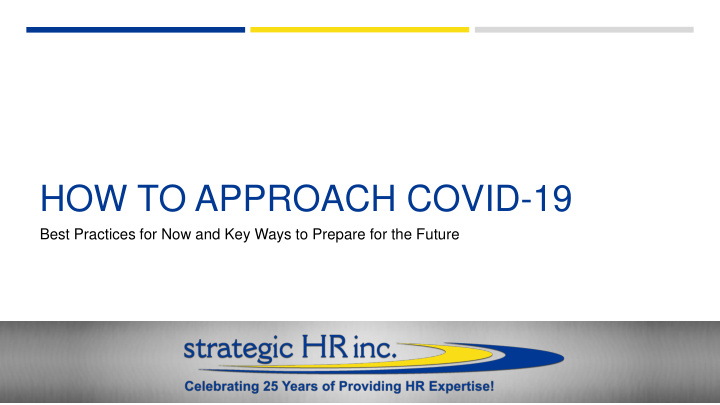



HOW TO APPROACH COVID-19 Best Practices for Now and Key Ways to Prepare for the Future
INTRODUCTIONS Samantha Osborne - Marketing Strategist Terry Salo - Sr. HR Consultant
AGENDA Introduction to Families First Coronavirus Response Act How to Reduce Stress Surrounding COVID-19 Ways to Maintain a Safe & Engaged Workforce Workforce Management Strategies
FAMILIES FIRST CORONAVIRUS RESPONSE ACT: LEAVE PROVISIONS The Families First Coronavirus Response Act is made up of two parts: Emergency Paid Sick Leave Act Emergency Family and Medical Leave (FML) Expansion Act Legislation provides a refundable payroll tax credit to employers to cover 100% of cost of wages.
EMERGENCY PAID SICK LEAVE Leave Reasons Subject to quarantine or isolation order 1. Advised to quarantine by health care provider 2. Experiencing COVID-19 symptoms and seeking medical diagnosis 3. Caring for an individual subject to isolation or quarantine due to COVID-19 4. Caring for child due to closure of school, place of care, or childcare is unavailable 5. Similar conditions specified by Secretary of Health and Human Services, Secretary of the 6. Treasury, Secretary of Labor
EMERGENCY PAID SICK LEAVE ACT Applies to ER’s with less than 500 EE’s Provides 80 hours paid leave (FT) / Pro-rated for PT There are limits: Regular rate of pay: not to Exceed $511 daily maximum ($5,110 aggregate) for quarantine or isolation order (Reasons 1-3) 2/3rds of Regular rate of pay: not to exceed $200 per day ($2,000 aggregate) for caring for an individual or care for son/daughter due to school closing or unavailable child-care (Reasons 4- 6)
EMERGENCY PAID SICK LEAVE ACT Employers required to post notice (DOL to supply) Non-Retaliation Provision No Carry-Over or Pay-Out Provision (if terminated) Exemption for ER’s with <50 Effective April 2, 2020 – December 31, 2020
EMERGENCY FML EXPANSION ACT Expanded Eligibility: Must be employed for 30 days Covered Employers: Applies to employers with < 500 EE’s Leave Reason: Closed schools/childcare providers “Emergency Leave” Protected Leave for up to 12 weeks
EMERGENCY FML EXPANSION ACT Obligations First 10 days of FMLA leave unpaid EE’s can Supplement with Vac/Sick/PTO (but ER’s cant require) 2/3 of pay capped at $200/day or $10,000 aggregate Job restoration
MANAGING STRESS & REASSURING EMPLOYEES Tune In Focus on what’s NOT changing Demonstrate Care & Concern Show & Encourage Gratitude Provide Reassurance Encourage Self-Care Keep Them Informed
STEPS TO TAKE ON LOCATION Six-feet apart Encourage remote work Take employees’ temperature Hand-washing & hand sanitizer Alter shifts to reduce the number of individuals interacting at a time Communicate clearly in multiple forms
CHALLENGES TO A REMOTE WORKFORCE Challenges to Overcome Building strong relationships Maintaining collaboration Reduced view into the day to day Avoid micromanaging!
REMOTE WORK - EMPLOYERS - Create opportunities for connection & collaboration Formal Opportunities: touch-base calls, one-on-ones Informal Opportunities: virtual happy hours Keep your check-ins & appointments Take a results-oriented approach Recognition
REMOTE WORK - EMPLOYEES - Prepare the following: Lay out the following: Structure Plans for: Hours Kids Appointments Pets Significant Others Workload Roommates
REMOTE WORK - EMPLOYEES - Prepare the following: Weaknesses & Rewards What do you struggle with? How will you reward yourself for focus? Manage Expectations Communicate!
COST CUTTING STRATEGIES Hiring Freeze Review PT Employees & Job Consolidation Freeze Salary & Benefit Increases Reduce Pay Rates or Work Hours Reduce Costs (travel, expenses, supplies) Consider Furlough (Temporary Lay-Off) Reduce Contract & Temporary Staff Eliminate Jobs through Lay-Off
COST CUTTING STRATEGIES Furlough Layoff Temporary in Nature Permanent Employee remains ‘employed’ but in Employment is terminated unpaid status Benefits are terminated Benefits remain in effect (most cases) Job is eliminated Temporary in nature (6-12 months) Can be intermittent
PRO’S & CON’S OF FURLOUGH PRO’s CON’s Reduce Costs Stress No Replacements Job Security
STEPS TO CONDUCT LAYOFF Select the Employees for Layoff Analyze for Adverse/Disparate Impact Review ADEA & OWBPA Regulations Determine Severance, Benefits & Additional Services Train Supervisors and Managers Prepare for & Conduct Layoff Meetings Notify the Workforce
QUESTIONS?
RESOURCES Families First Coronavirus Response Act Employer’s Resource Guide to Coronavirus – strategic HR inc. Six Ways to Protect Yourself and Your Family From Anxiety - Thrive Global Are You Worried About Coronavirus? – Psychology Today 9 Tips to Make Working From Home Work for You – NPR How to Get People to Actually Participate in Virtual Meetings – Harvard Business Review The Manager’s Manual for Remote Work – Slack Blog
THANK YOU! Terry Salo Terry@strategicHRinc.com 513.697.9855 (ext. 318) Samantha Osborne Sam@strategicHRinc.com 513-697-9855 (ext. 316)
Recommend
More recommend